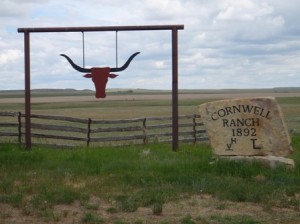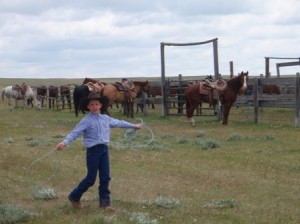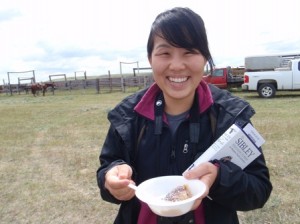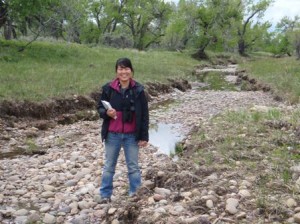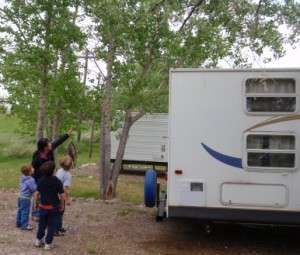Amy Briggs (pomona ’10) and I will be running a Monitoring Avian Productivity and Survivorship (MAPS) station and conducting point counts out in Valley County, Montana over the course of the summer. With any luck, the weather will be on the sunnier (i.e. not rainy) side so that we’ll have more time to spend in the field.
A MAPS station is a formal term denoting a bird-banding site supervised by a permit-holding bird bander. Bird banding entails catching a bird in a mist net (a superfine almost invisible net), and subsequently placing a federally-issued numbered metal band on their leg. Because the bird is so close (it’s in your hand!), the researcher can make very detailed assessments about its physical condition. This allows for researchers to track the persistence of different individuals (using the time between recaptures) as well as other population parameters, such as age structure. The Institute for Bird Populations (IBP), U.S. Geological Survey (USGS) jointly administer an online database of bird bands so that recaptures and historical trends can all be analyzed using banding data.
John Carlson, a wildilfe biologist at the Bureau of Land Management, will be supervising our study, and Nina Karnovsky (both are experienced and helpful birders) is our faculty advisor. Nina has been extremely kind; she took the time out of her schedule to come bring me up to Fort Peck, Montana and is staying for a whole week to help set up our project.
We scoped out the study site today–it’s located in a valley at the Cornwell Ranch. The area is more or less ecologically pristine; there has been grazing which helps maintain the prairie but no development (save for a two-lane dirt road). The landscape is absolutely beautiful (think: grassland stream surrounded by cottonwoods, silver sage [which is soft and fuzzy to touch], prairie smoke [a fuschia flower], etc.) and the ranch is still in operation! It’s a cow-and-calf deal, meaning that they raise calves and maintain a population of breeding cows that graze on the surrounding grasslands. And on the real, the place is huge. It took us approximately 20-30 minutes just to drive from the gates of the ranch to the study site.
There were quite a few birds out today, including Western Meadowlark, Yellow Warblers, House wrens, a potential Bullock’s and Baltimore Oriole hybrid (exciting), Upland sandpipers, Long-billed curlews, Western and Eastern Kingbirds (think: Western = casual, Eastern = tux), Barn swallows (awesome), Spotted Towhees, Vesper sparrows, Clay-colored sparrows, McCown’s Longspur, and Chestnut-collared longspur. John heard a Spragues pipit near a cattle pasture but the cows were all mooing too loudly. However, apart from the birds, we saw an even rarer species: cowboys riding HORSES (not two/four wheelers). The group of cowboys ranged from around 3-5 years old to 50+ years old judging from the looks of things. I got to eat some home-made peach cobbler (drenched in half-and-half, interesting) which was cinnamon-flavored gooey tastiness.
The cowboys mentioned that they really appreciate the work that John’s been doing with the local birds because it has further strengthened their commitment to preserving the habitat at their ranch. It also has given them a scientific basis to argue for preserving their land as a site of high avian activity and diversity.
Montana’s short-grass prairie is a rapidly declining ecosystem because of pressures to convert it to cropland and urban development (less of a threat now, but a huge player in areas such as California with our own highly threatened Coastal sagebrush ecosystem). It is a glorious landscape, and Montana isn’t called “Big Sky Country” for nothing–the clouds are so large and so close that it seems like you too could join an American robin hopping by your side and fly into the sky.
Glasgow is semi-rural and even in the trailer park, I’ve seen an abundance of species. So far, the “yard list” comprises: house finches, cedar waxwings, American robins (there’s a nest behind my trailer with at least 2 fledglings!), and Common grackles.
We’re hoping to get the MAPS station up and running by this Friday! Wish us luck, and you can even help us out by thinking “rain, rain go away” (at least until the end of this week). Pictures will either be coming throughout the summer or at the end of August (I think I forgot my uploading cable, whoops).


